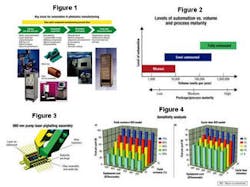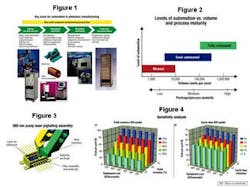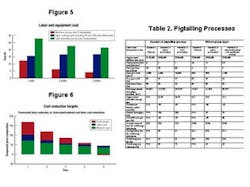Component manufacture: Making the case for automation
RANDY HEYLER
Newport Corp.
The overwhelming demand for increasing volumes of optical components for fiber-optic networks that characterized much of 1999 and 2000 has radically shifted to intense pressure to reduce manufacturing costs. Automation of critical test, measurement, inspection, and assembly processes is key to both supply and cost problems. However, little is understood about the actual economic benefit realized through automation or its impact on other areas such as labor cost, design methods, and ultimately the overall cost equation.
Several business case studies on the economic effect of introducing semi- and fully automated equipment into the photonics component manufacturing process can help highlight the issues and opportunities offered by automation of current-generation components. Further, the potential impact of manufacturing location and labor cost, as well as design-for-manufacturing methods, are explored as a complement to the automation approach. Finally, some conclusions regarding the limitations of automation cost savings with respect to overall cost reduction requirements are offered.
Automation landscape today
The photonics industry is best characterized as still in its infancy with respect to the immaturity of both product technology and manufacturing processes. While photonics is similar to the electronics and semiconductor industries from which it evolved, there are several important differences, which are limiting the introduction of automation tools:
• Package and component designs are mostly incompatible with highly automated assembly. Aside from the additional difficulty of handling fiber, the majority of current photonic component designs were created to achieve performance, not cost objectives.
• Assembly tolerances are more stringent, both with respect to magnitude (submicron vs. micron) and directionality requirements (needed for light coupling).
• Yields are low. That is due to the combination of highly manual operations, lack of process controls on incoming parts and assembly methods, and a general lack of understanding of process capabilities.
• Standards for form factors and manufacturing processes are lacking. That limits the ability of machine tool providers to develop cost-effective equipment for key test, inspection, and assembly processes.
• Volumes are still relatively small. Manufacturing requirements are still in the area of thousands per month, tiny by comparison to the electronics or semiconductor industries.
Nonetheless, significant progress has been made over the past 5 years in the development and introduction of semi- and fully automated equipment for backend packaging of photonics components. Figure 1 shows where automation has been successfully introduced into the key areas of pretest, inspection, assembly, and final test processes. Typically, these implementations have required a significant level of application engineering and/or customization in order to adapt the machine tools to the specific requirements of each vendor. However, even with this additional cost of implementation, current generation automation tools can be quite cost-effective.
Quantification model
When attempting to measure the benefits of automation implementation, cost savings, or efficiency improvements, are typically realized in the following categories:
• Labor savings. Labor savings are often a result of an automation tool being able to do the task faster, or of a lower skill level of operator being required.
• Yield improvement. With better process control, yields will go up, reducing scrap material and rework labor.
• Floorspace and operator utilization. By automating, the output per operator and unit per floorspace will typically increase dramatically.
A financial model compares various scenarios for assessing the volume, yield, and cost improvements that can be gained by employing various levels of automation. The inputs and outputs to the model are summarized in Table 1. For these analyses, it is also important to evaluate the appropriate level of automation for each application, which are defined as follows:
• Manual. Operator performs all functions, and some mechanization or fixturing required.
• Semiautomated. Manual loading and unloading, typically one part at a time; motorization/automation for critical processes; use of computer for data management and process control; "eliminate operator dependency, not the operator".
• Fully automated. Truly unattended operation under computer control; operator loads multiple parts/trays; multiple part processing between loads.
- Table 1: Model inputs and outputs
Inputs
Equipment cost
Amortization period
Throughput/cycle time
Number of operators per machine
First pass yield
Utilization factor (uptime)
Burdened labor rate
Factory overhead rate
Current assembly cost (for calculating payback)
Outputs
Total yielded throughput per shift--1, 2, and 3 shifts
Yielded cost per part
Payback period (when compared to current method)
While full-scale automation often will look the most promising from the financial analysis standpoint, if the production volume or process maturity isn't high enough, a fully automated machine tool will simply make scrap at a faster rate. Figure 2 shows the approximate relationship between part volumes and process maturity with respect to automation level. The conclusion here is that fully unattended automation is usually only economically viable at part volumes in the 100,000 per year and up, and on components whose manufacturing process is very well developed, understood, and under control.
It is helpful to examine case studies for assembly automation of two popular types of optoelectronic packages: a butterfly 980-nm pump module, and a coaxial 1310-nm OC-12 laser-diode module. These scenarios first summarize the equipment and labor costs of performing a specific assembly process and then use similar labor/overheard rates and amortization periods in order to quantify the relative benefits between each case. Secondly, the effects of reduced scrap costs are brought into play to highlight these additional potential savings, although these absolute numbers are much more sensitive to the actual material costs and yields.
The absolute numbers for cycle times and yields presented here have been demonstrated for specific part configurations; however, some variations can be expected depending on the specifics of a given application or company circumstances.
Case 1: A 980-nm pump fiber pigtailing assembly. The alignment and attachment of a lensed fiber inside the butterfly package for this device is one of the most challenging assembly operations in all of photonics. The fiber must be carefully threaded through the package snout, aligned to optimum power coupling in front of the laser waveguide, and then bonded in place within an overall assembly tolerance of just 150 nm (see Figure 3). That is more stringent by a factor of 5 to 10 compared to most other types of optoelectronics modules.
This case, summarized in Table 2, models three different scenarios. The first scenario is the "current" process, using a mostly manual setup with some mechanization and operator feedback for alignment and laser welding. The setup is tedious and the results (cycle time, yield) fairly operator-dependent. Scenario 2 introduces a semi-automated platform, which is still manually loaded but automates the alignment, attachment, and data tracking processes. The process yield and cycle time both improve accordingly. Scenario 3 introduces palletized tooling whereby the parts come into the machine already pre-populated on a carrier, thus reducing the load and unload time and further improving the yield and utilization factor based on reduced part handling.
Table 2 highlights the significant cost savings and efficiency improvements that can be achieved on this assembly process with current-generation automation tools, reducing cost and improving throughput by nearly a factor of three.
Case 2: Coaxial 1310-nm laser-diode pigtailing assembly. The coaxial style module used for many OC-12 (622-Mbit/sec) transceiver modules is a more common assembly with more forgiving assembly tolerances in the 700-1000-nm range. This type of assembly is more compatible with material handling automation as no fiber threading through a package snout is required. Fully automated and unattended operation for devices of this class has been successfully proven, with cycle times in the 45-80-sec range. Since the operation does not require attention from the operator except for replenishment of multipallet cassettes, a single operator can manage several workstations at once, virtually eliminating the labor content on a per-part basis.
Table 2 also summarizes the comparison of manual, semi-automated, and fully automated operation. For this case, throughput improvements and assembly cost reductions reach nearly a factor of seven.
What is interesting to note in these analyses is the respective leverage of machine cost, yield, and cycle time. Figure 4 plots the total cost for this process for the 980 semi-automated example, including yield/scrap cost versus machine cost and cycle time or first-pass yield. Note that the impact of machine cost is nearly negligible across both diagrams, reflecting the decreasing effect of machine cost when volume reaches maximum levels. However, in this example the high yield/scrap cost for a bad part creates a huge opportunity for overall cost reduction by improving the process control and part handling.
Secondly, it is important to understand that eventually the labor component dominates the labor/equipment equation. Figure 5 shows that as volumes and machine use increase, the equipment cost component dissolves and the labor component becomes the limiting factor. That means if one operator can service several machines, or if the machine is run in a low-labor-cost environment, substantial additional benefits can be realized.
Automation's role
While current automation methods may reduce process costs by nearly an order of magnitude, ultimately these cost savings can only resolve some of the continuous cost pressures of the market, which often demands as much as 20-30% price reductions on components each year. Figure 6 shows a normalized material, labor, and profit margin mix for a typical photonics component versus the forecasted price target of a 30% annual price reduction. This analysis assumes that without major design changes the OEM component supplier can reduce materials costs 15% per year, lower labor through automation by a factor of 4, and that the component is comprised of 70% materials cost and 30% labor cost, with a starting gross margin of 40%.
Those are aggressive assumptions on the benefits of automation and supply-chain management and include labor cost reductions of 50% in year two and another 50% in year three due to implementation of automation, plus a 15% annual reduction in material costs. Still, it is evident that even with these aggressive assumptions, the margin on the product shrinks to an unacceptably low level by year three and nearly disappears by year four.
Automation has become a viable part of the cost-reduction equation and has been successfully applied over many different process areas, contributing in some cases nearly an order of magnitude reduction in processing costs. In most cases it is the improvement in yields and throughput that have the most impact, quickly overcoming the initial costs of the equipment. However, automation can only go so far in the quest to achieve continuous cost reduction, and it is imperative that more fundamental approaches to cost reduction through design for manufacturability and assembly be applied in order to meet future cost reduction targets.
Randy Heyler is vice president of marketing at Newport Corp. (Irvine, CA).


